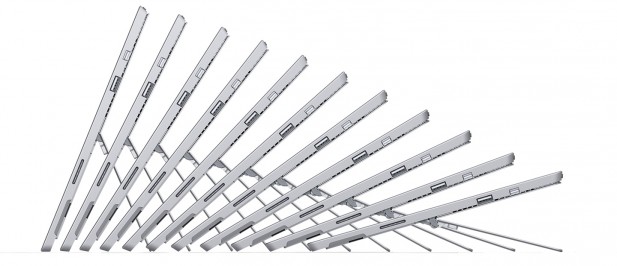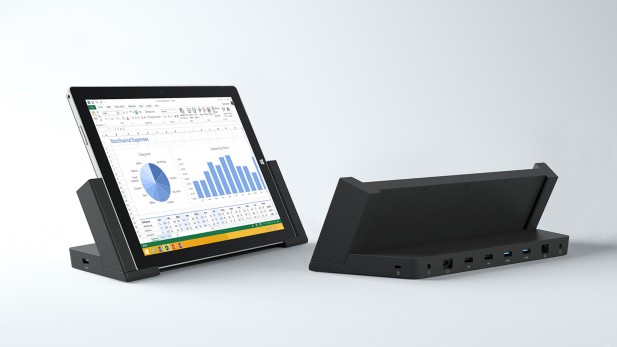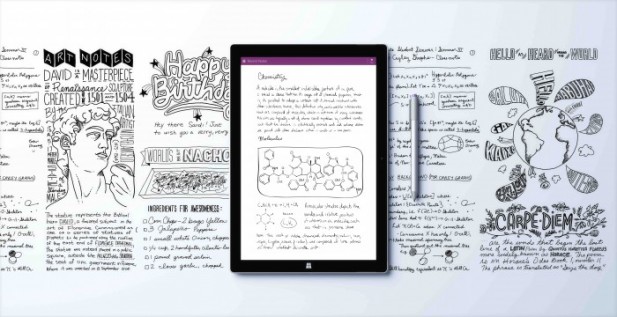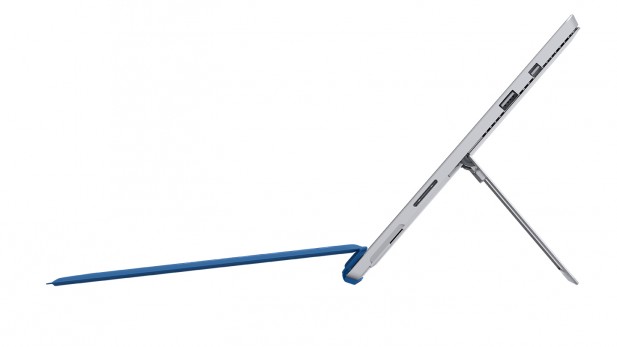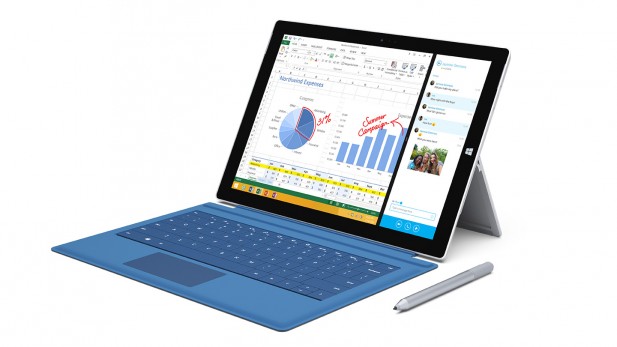Today Microsoft launched the third iteration of its Surface tablet line: the Surface Pro 3. Like prior Surface Pro models the Surface Pro 3 runs the x86-64 version of Microsoft’s Windows 8.1 operating system and comes with a keyboard and an input pen. But unlike the old surfaces Microsoft has switched to a 3:2 aspect ratio screen from a traditional 16:9 screen. With a 2K resolution or 2160 by 1440 these displays come color-calibrated from the factory for the best display accuracy. More than just the aspect ratio switch though Microsoft has also increased the physical size of the device to a full 12” diagonally while at the same time decreasing the thick ness of the device to just 0.36”. At the launch event Microsoft was touting the Surface Pro 3 as the thinnest Intel Core-based device in existence thanks to a close collaboration with Intel. The whole device only weighs 1.76 pounds making it lighter than certain models of the Macbook Air.
[youtube_sc url=”http://youtu.be/1t7rSZT_77E” autohide=”1″ fs=”1″]
On the computing side the Surface Pro still uses Intel’s ULV i3, i5, i7 Haswell-based chips and comes with 8 GBs of RAM. Storage options range from 64 GBs to 512 GBs and there’s now a microSD card reader built-in. For I/O options the Surface Pro 3 still remains limited to one USB 3.0 port, a headset jack, miniDisplay port, and two proprietary ports for the keyboard cover and battery charging. There are front and rear facing 5 Megapixel cameras on the Surface Pro 3, but judging from the test shots they’re not exactly great cameras. They also improved the onboard speakers and are now offering 802.11ac WiFi support. Interestingly battery life is quotes at nine hours which is a big improvement from the original Surface Pro which managed about four hours of battery life.
There’s also the new kick stand. The first generation had a kick stand with one open position, the second generation has two open positions, and the third generation is a full-friction kick stand allowing you to place it at whatever angle you want from 0 to ~150 degrees. Additionally there’s a docking station for turning your laptop replacement into a desktop replace when you need more USB ports or display outputs. As docking stations go the Surface one is rather svelte, but this is an option aimed mostly at corporate users rather than mainstream consumers.
With all of the technically specifications out of the way there is few reasons why the launch of Surface Pro 3 is important. First off there’s Intel which is now at full speed working to support Android devices to fight ARM. Many had suggested that Intel’s current focus on Android would limit its attention toward Windows-based products, and while that still maybe true to a degree with the launch of the Surface Pro 3 it’s clear that Intel is still very much involved in the cutting edge of the Windows ecosystem.
Then there’s the aspect ratio and screen size of the new Surface. In its press materials Microsoft said that the inspiration for the form factor of the Surface Pro 3 came from a writing pad, or tablet of note taking paper. Prior to now Microsoft had been using the 10.2” screen size and 16:9 aspect ratio which was excellent for videos, video games, and a number of other applications. But many people criticized it for being comparably harder to put a full-page of formatted text on than an iPad’s 4:3 aspect ratio screen. With the Surface Pro 3 Microsoft’s gone in the complete opposite direction by designing a tablet that has the same form factor as a traditional paper tablet rather than a form factor more similar to a brochure. This is a concession to iPad fans, but I must give Microsoft at least some credit for having a decent line of reasoning behind the change rather than just copying the iPad like Android tablet manufactures are prone to do.
In Microsoft’s quest to build a laptop replacement the Surface Pro 3 looks to be the first offering that can really meet that goal. The screen size is finally large enough to be usable, the battery life is decent, the hardware specifications are good, and the price is reasonable. The Surface Pro 3 is a Macbook Air killer and judging by how many times Microsoft compared the Surface Pro 3 to the Macbook Air it’s clear that the Macbook Air was their development target. As far as the hardware is concerned the Surface Pro 3 is as good as it gets, Microsoft has built the best Intel 2 in 1 in existence.
But it runs Windows 8.1 and here where things get really murky. Consumers have consistently avoided Windows 8.x products since they launched. For Microsoft this means that despite having the best hardware platform money can buy, it’s extremely hard to say whether or not this device will sell. To that end I’m going to suggest that people are going to buy the Surface Pro 3 based solely on its strengths as a laptop rather than on its credibility as a tablet or iPad competitor. Considering the slump in PC sales lately this means that the Surface Pro 3 probably won’t sell like iPads and Nexus’s simply due to the price differential. But will likely do better than the first two generations of products by addressing the massive Windows laptop market, rather than the comparatively small Windows tablet market.
With all that said the Surface Pro 3 is a really interesting product. Were we not already committed to building a gauss cannon onto the orbital laboratory I’d be asking for a Surface Pro 3 as a replacement for my aging ThinkPad. Congrats to Microsoft on a solid mid-cycle update and to Intel for demonstrating their commitment to Intel Core series based tablets.S|A
Thomas Ryan
Latest posts by Thomas Ryan (see all)
- Intel’s Core i7-8700K: A Review - Oct 5, 2017
- Raijintek’s Thetis Window: A Case Review - Sep 28, 2017
- Intel’s Core i9-7980XE: A Review - Sep 25, 2017
- AMD’s Ryzen Pro and Ryzen Threadripper 1900X Come to Market - Aug 31, 2017
- Intel’s Core i9-7900X: A Review - Aug 24, 2017

